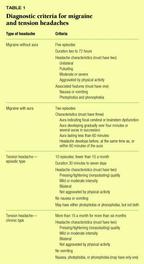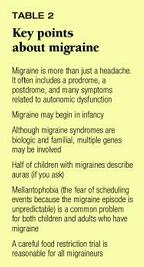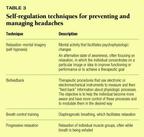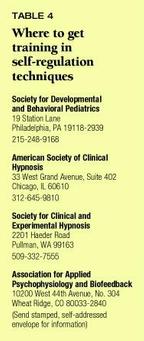Managing headaches without drugs
Are self-regulation techniques, not pills, the best way to prevent and manage migraine and tension-type headaches? In many cases, this practitioner believes, the answer is Yes.
Managing headaches without drugs
By Karen N. Olness, MD
Are self-regulation techniques, not pills, the best way to prevent and manage migraine and tension-type headaches? In many cases, this practitioner believes, the answer is Yes.
Most review articles and texts on headaches in children provide long lists of suggested pharmacologic interventions, and many patients find these agents helpful. Yet clinical trials of nonpharmacologic prevention and treatment of headache in children outnumber those of drugs and show that alternative treatments are often effective. My own experience using self-regulation to prevent or manage migraine supports these findings. Consequently, I believe that until we have research data suggesting otherwise, nonpharmacologic interventions for migraine are preferable to those that rely on drugs as an initial approach. I will show how to recognize migraine and tension headaches and find out what causes them, outline a plan for practicing self-regulation and offer some hints for increasing the likelihood these interventions will be successful, and review study findings.
According to epidemiologic studies, the prevalence of headaches in children and adolescents ranges from 21% to 55%.1,2 Migraine occurs in from 4% to 10% of youngsters.3,4 A study in Cleveland in 1997 found that 8.6% of school children met International Headache Society criteria for migraine, yet physicians had diagnosed migraine in only 20% of these children. Most took over-the-counter drugs or simply suffered.5 This is unfortunate, since migraine causes lost time from school and play as well as family stress.6 The costs of migraine to society are huge, both economically and in terms of family disruption.
Causes of headaches
Before deciding how to prevent or treat a headache, it's important to determine its cause. Ask detailed questions about the symptoms the International Headache Society has identified as criteria for migraine and tension headaches (Table 1), and about diet and lifestyle. Having the child keep a headache diary is helpful; it should specify when each headache began, what the child was doing, how long the headache lasted, associated symptoms, and how the headache was treated.

Distinguishing between tension headache and migraine can be difficult because, especially in children, the symptoms of the two often overlap. A recent study of 150 children in England suggests that in youngsters signs and symptoms of headache do not correlate well with International Headache Society classifications.7 Instead, findings are consistent with the continuum theory of headaches, which presents tension and migraine headaches as the ends of a spectrum, not discrete entities.
The causes of headaches in children diagnosed as having migraine and referred to the behavioral pediatrics clinic at Rainbow Babies and Children's Hospital have included carbon monoxide poisoning, brain tumor, arteriovenous malformation, slipped cervical disc, prolonged use of medications such as cimetidine, hydrocephalus, sinusitis, dental abscess, brain abscess, excessive Vitamin A, cyclic vomiting syndrome, and intolerance of monosodium glutamate. Given such a broad range of causes, careful evaluation may require magnetic resonance imaging, a computed tomography scan, a dental referral, or a check of the home furnace. Table 2 lists some points that are important to an understanding of migraine.

Food a common trigger
A 1983 study by Egger documents that foods can trigger headache in many children.8 These foods may be meats, vegetables, grains, or fruits; often trigger foods are those the child eats frequently. Migraine syndromes in children and adolescents in our clinic have been caused by corn, soybeans, apple juice, bananas, and pork.
I recommend a careful food elimination trial for children with recurrent headaches, be they migraine or the tension type. The protocol Egger used was rigorous, calling for an oligoantigenic diet limited to four foods: one meat (lamb or chicken), one vegetable, one fruit, and one carbohydrate for a three-week period. Selections were not from foods the child usually ate, and investigators were careful to avoid foods from the same family as foods the child usually preferred. After three weeks, one new food was added to the child's diet every seven days. Foods that provoked symptoms were again withdrawn. Later, a double-blind, placebo-controlled crossover-trial tested responses to each of the foods that provoked symptoms in the reintroduction phase. Of 88 patients completing the diet, 78 recovered on the first or second diet trial and four improved greatly. Of these 82, all but eight relapsed when the offending food was reintroduced.
In clinical practice, we do not use a blind challenge, nor do we limit children to only four foods. During the food restriction trial, we help the child and family select eight or 10 foods the child rarely eats from the major food groups. If the child usually eats potatoes, for example, one might choose rice as a carbohydrate for the elimination trial. It is also helpful to eliminate all foods in a given family by consulting a manual that lists foods by antigen group. Migraine episodes should decrease within two weeks of removing the offending food from the diet. An initial trial of three weeks should be sufficient in the child who has only one or two episodes a month.
Evaluating prevention strategies
Once you are satisfied that a child has either migraine or tension headaches, I recommend trying to prevent them using nonpharmacologic approaches. One method is to identify and eliminate triggers, such as foods or stressors at home or school. Another is to train the patient in self-regulation strategies such as self-hypnosis or biofeedback. Pediatricians unfamiliar with self-regulation may have several questions about this approach.
How do self-regulation strategies work? Self-regulatory skills, also called cyberphysiologic skills, enhance people's abilities to direct their own behavior, bring about desired physiologic changes, and control their thoughts. The goal is to control symptoms, attain and maintain health, improve functioning, or enhance performance. Techniques include relaxation and mental imagery (self-hypnosis), breath control, biofeedback, and progressive relaxation (Table 3).911 In addition to alleviating headache, self-regulation methods enhance self-esteem, feelings of personal mastery, and coping skills.

How do I learn to coach patients in self-regulation? Before teaching these skills, the clinician must take a workshop in basic hypnosis or biofeedback from a professional training organization (Table 4). Most workshops last three days and afford ample time for practice. After completing the workshop, the clinician should select a mentor from the faculty who will be available to answer questions and make suggestions about specific clinical problems. The case histories in the box ("Self-regulation in practice: Two case histories") show how a pediatrician can use these coaching skills to work with a patient.


Compared with drugs, how effective is self-regulation in controlling headaches? The many controlled studies demonstrating the effectiveness of nonpharmacologic interventions include trials of school-based training in relaxation for children with headaches, relaxation prophylaxis for juvenile migraine, autogenic feedback training, temperature feedback in the treatment of children with migraine, and mast cell activation in child migraine patients before and after training in self-regulation. Other trials compare biofeedback treatment for pediatric migraine in the home and the clinical setting and self-hypnosis and propranolol in the treatment of juvenile classic migraine. These studies1218 show that 70% to 80% of headache episodes can be completely prevented in children willing to practice self-regulation methods over a period of a few months. A recent study compared psychological (progressive relaxation and biofeedback) and drug treatment (metoprolol).19 The self-regulation treatment was administered in 10 sessions lasting six weeks; the drug treatment lasted 10 weeks. The self-regulation methods reduced the headache index more effectively than metoprolol, and eight months later the clinical improvement had been maintained.
Only a few controlled studies of propranolol treatment or other drugs commonly used for preventing migraine have been conducted with children. In one study, children who took prophylactic propranolol had fewer migraine episodes than those who had a placebo.20 Another study found no such difference between the two groups.21 The literature does contain some uncontrolled studies of sumatriptan and dihydroergotamine mesylate for acute episodes of migraine in children and one controlled crossover trial comparing ibuprofen and acetaminophen.2224 All the drugs partially relieved acute symptoms of migraine, but sumatriptan and dihydroergotamine were associated with side effects. Among the significant side effects of drugs used for migaine are cardiac slowing (propranolol); flushing, chest pain, and burning scalp (sumatriptan); and acute fear and agitation (dihydroergotamine mesylate). Metoclopramide, believed to enhance the effectiveness of analgesic drugs for migraine by counteracting the gastric stasis that often accompanies migraine episodes, can cause dystonia.
Setting the stage for self-regulation
It generally takes three or four visits during a two-month period to teach a self-regulation method.
First visit. Carefully assess whether diagnostic studies are indicated. Ask about the child's lifestyle, interests, likes, dislikes, and school performance. If the child agrees, begin by teaching a simple relaxation-imagery exercise.
Second visit. This should take place a week to 10 days after the first. Find out how often the patient practices self-regulation at home, where, and for how long. Build on the previous training, adding a biofeedback experience, if possible. Add specific suggestions for pain control, such as imagining turning off a switch on a computer control system.
Third visit. Schedule this appointment two to three weeks after the second visit. Record headache episodes, review previous training, and answer questions. Agree to type of follow-up. If the child's headaches have decreased, consider following up by phone or E-mail instead of scheduling an office visit.
Prognosis. The following guidelines should help you assess whether a child is a good candidate for the training and enhance the likelihood of its success:
- Spend enough time to get to know the child. Is he willing to do the necessary practice? What are his likes, interests, fears, preferred imagery, and learning styles? Find out what aspects of the headache episodes trouble him most, so you can focus on them. Many children find the nausea and vomiting worse than the headache itself.
- Ask the child to draw how the headache feels, including its location, color, and other characteristics. The drawing will give you insight into the child's perception of the discomfort and can guide therapeutic suggestions.
- Make a drawing for the child, explaining pathways of pain perception and noting that the average person does not pay close attention to all sensory stimuli coming into her brain. This will help the child understand how she can mentally control the pain she feels. If possible, give the child an opportunity to experience biofeedback so she can recognize that a change in one's thinking results in bodily changes. For example, tape a temperature sensor to the child's fingertips so she can see how the temperature rises as she relaxes.
- When teaching relaxation, use imagery that appeals to the child, not to the clinician or parents.
- Emphasize that parents should not remind the child to practice the techniques she learns; the first step in learning self-regulation is to do the practicing on one's own initiative. It is all right, however, for parents to help the child devise a way to remind herself to practice.
- Make clear that the child who learns to prevent or reduce headaches deserves full credit for her success.
- Ask the child to rate future headaches on some sort of severity scale--by number, on a drawing of a ruler, or by color, for example. A consistent rating method makes it possible to compare the intensity of the child's headaches over time.
The final word
Children and adolescents respond well to self-regulation methods of preventing headaches. The literature supports this approach, with more controlled studies demonstrating the efficacy of nonpharmacologic interventions for headache in children than demonstrating the efficacy of medications. Because recurrent headaches often continue into adulthood, children should be taught these methods as early as possible, not only to reduce discomfort but to enhance their sense of personal mastery.
THE AUTHOR is Professor of Pediatrics, Family Medicine, and International Health at Case Western Reserve University School of Medicine, Cleveland, OH, and Director, International Child Health Center, Division of Behavioral Pediatrics, Rainbow Babies and Children's Hospital, Cleveland.
REFERENCES
1. Abu-Arefeh I, Russell G: Prevalence of headache and migraine in schoolchildren. BMJ 1994;309:765
2. Sillanpaa M, Anttila P: Increasing prevalence of headache in 7-year-old schoolchildren. Headache 1996;36:366
3. Olness KN, MacDonald JT: Recurrent headaches in children: Diagnosis and treatment. Pediatr Rev 1987; 8:307
4. Lipton RB, Siberstein SD, Stewart WF: An update on the epidemiology of migraine. Headache 1994;34:319
5. Lee LH, Olness KN: Clinical and demographic characteristics of migraine in urban children. Headache 1997; 37:269
6. Smith R: Impact of migraine on the family. Headache 1998;38:423
7. Viswanathan V, Bridges SJ, Whitehouse W, et al: Childhood headaches: Discrete entities or continuum. Dev Med Child Neurol 1998;40:544
8. Egger J, Carter CM, Wilson J, et al: Is migraine food allergy? A double-blind controlled trial of oligoantigenic diet treatment. Lancet 1983;2:865
9. Olness K, Kohen DP: Hypnosis and Hypnotherapy with Children, ed 3. New York, NY, Guilford Press,1996
10. Culbert T, Reaney JB: Biofeedback and self-regulation skills training for children. Biofeedback 1998;26:10
11. Sugarman LI: Hypnosis: Helping children help themselves. Contemporary Pediatrics 1996;13(11):107
12. Larsson B, Melin L: Chronic headaches in adolescents: Treatment in a school setting with relaxation training as compared with information-contact and self-registration. Pain 1988;30:626
13. McGrath PJ, Humphreys P, Goodman JT, et al: Relaxation prophylaxis for childhood migraine: A randomized placebo-controlled trial. Dev Med Child Neurol 1988; 30:626
14. Labbe EE, Williamson DA: Treatment of childhood migraine using autogenic feedback training. J Consult Clin Psych 1984;52:968
15. Burke EJ, Andrasik F: Home vs. clinic based biofeedback treatment for pediatric migraine: Results of treatment through one year follow-up. Headache 1989;29:434
16. Labbe EE: Treatment of childhood migraine with autogenic training and skin temperature biofeedback: A component analysis. Headache 1995;35:10
17. Olness K, MacDonald JT, Uden DL: Comparison of self-hypnosis and propranolol in the treatment of juvenile classic migraine. Pediatrics 1997;79:593
18. Olness K, Hall H, Rozniecki JJ, et al: Mast cell activation in child migraine patients before and after training in self-regulation. Headache 1999 (in press)
19. Sartory G, Muller B, Metsch J, et al: A comparison of psychological and pharmacological treatment of pediatric migraine. Behav Res Ther 1998;36:1155
20. Ludvigsson J: Propranolol used in prophylaxis of migraine in children. Acta Neurol Scand 1974;50:109
21. Forsythe WI, Gillies D, Sills MA: Propranolol (Inderal) in the treatment of childhood migraine. Dev Med Child Neurol 1984;26:737
22. MacDonald JT: Treatment of juvenile migraine with subcutaneous sumatriptan. Headache 1994;34:581
23. Hamalainen ML, Hoppu K, Santavuori PR: Oral dihydroergotamine for therapy-resistant migraine attacks in children. Pediatr Neurol 1997;6:114
24. Hamalainen ML, Hoppu K, Valkeila E, et al: Ibuprofen or acetaminophen for the acute treatment of migraine in children: A double-blind, randomized, placebo-controlled, crossover study. Neurology 1997;48:103
Karen Olness. Managing headaches without drugs.
Contemporary Pediatrics
1999;8:101.




















